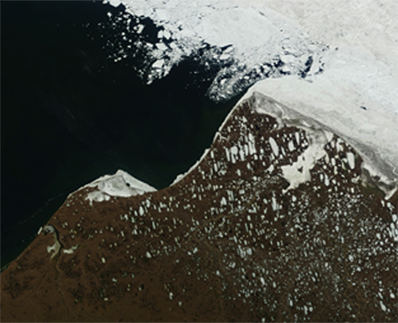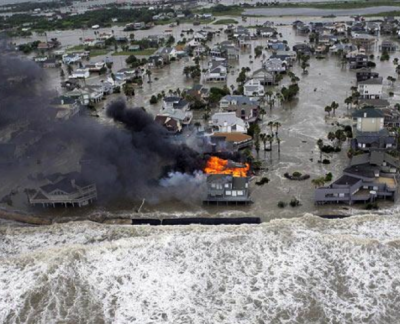Science spotlights: Difference between revisions
m (→Boom-and-bust cycles of barrier island retreat: built->build) |
m (added science highlight) |
||
| Line 1: | Line 1: | ||
= Science spotlights = | = Science spotlights = | ||
{{TOC limit|3}} | {{TOC limit|3}} | ||
==Retreating Arctic Coasts== | |||
<p align="left"><font color="gray">''Science in the spotlight: April 2011 - June 2011''</font></p> | |||
[[image:ArcticCoastforScienceHighlight.png|400px|right|wrap|thumb|link=|Coastline of North Alaska]] | |||
The coastline in Arctic regions reacts to climate change with widespread increased erosion by 0.5 m per year. Coastal change is particularly dramatic in the Laptev, East Siberian and Beaufort Seas, where coastal erosion rates reach more than 14 m/year. Since around a third of the world’s coasts are located in the Arctic permafrost, coastal erosion may affect enormous areas in future. In general Arctic coasts react more sensitively to global warming than coasts in the mid-latitudes. Up to now these coasts have been protected against the eroding force of the waves, and warm sea water by sea ice cover. Due to the continuous decline in sea ice area extend, this protection is jeopardized. | |||
Two thirds of the Arctic coasts consist of frozen sediments. And precisely these coasts are extremely hard hit by erosion. As a rule, Arctic regions are quite thinly populated. However, as nearly everywhere in the world, the coasts in the far north are important axes for economic and social life. The growing need for global energy resources as well as increasing tourism and freight transport additionally intensify anthropogenic influence on the coastal regions of the Arctic. For wild animal stocks, like the great caribou herds of the north, and the widespread freshwater lakes near the coast progressive erosion brings about significant changes in ecological conditions. | |||
More than thirty scientists from ten countries were involved in preparing the 170-page status report entitled “State of the Arctic Coast 2010”. The study was initiated and coordinated by the International Arctic Science Committee (IASC), the international joint project Land-Ocean Interactions in the Coastal Zone (LOICZ), the International Permafrost Association (IPA) and the Arctic Monitoring and Assessment Programme (AMAP) working group of the Arctic Council. | |||
===Links=== | |||
* [http://www.loicz.org/press/index.html.en http://www.loicz.org/press/index.html.en] | |||
* [http://www.arcticcoasts.org/ http://www.arcticcoasts.org/] | |||
* [[Media:State_of_the_arctic_report2010.pdf | PDF of report]] | |||
Movies of coastal retreat can be found in the CSDMS EKT repository: | |||
* [[Real_event_movies]] | |||
==Boom-and-bust cycles of barrier island retreat== | ==Boom-and-bust cycles of barrier island retreat== | ||
<p align="left"><font color="gray">''Science in the spotlight: December 2010 - | <p align="left"><font color="gray">''Science in the spotlight: December 2010 - April 2011''</font></p> | ||
[[image:Galveston_Ike.png|400px|right|wrap|thumb|link=|Galveston Barrier Island, on September 9, 2008. Ike made its final landfall near [http://en.wikipedia.org/wiki/Galveston Galveston], [http://en.wikipedia.org/wiki/Texas Texas]. Galveston experienced a bust after a major 1900 storm, but recovered as a tourist resort from the 1930’s onwards. It remains vulnerable today.]] | [[image:Galveston_Ike.png|400px|right|wrap|thumb|link=|Galveston Barrier Island, on September 9, 2008. Ike made its final landfall near [http://en.wikipedia.org/wiki/Galveston Galveston], [http://en.wikipedia.org/wiki/Texas Texas]. Galveston experienced a bust after a major 1900 storm, but recovered as a tourist resort from the 1930’s onwards. It remains vulnerable today.]] | ||
Revision as of 07:35, 23 April 2011
Science spotlights
Retreating Arctic Coasts
Science in the spotlight: April 2011 - June 2011
The coastline in Arctic regions reacts to climate change with widespread increased erosion by 0.5 m per year. Coastal change is particularly dramatic in the Laptev, East Siberian and Beaufort Seas, where coastal erosion rates reach more than 14 m/year. Since around a third of the world’s coasts are located in the Arctic permafrost, coastal erosion may affect enormous areas in future. In general Arctic coasts react more sensitively to global warming than coasts in the mid-latitudes. Up to now these coasts have been protected against the eroding force of the waves, and warm sea water by sea ice cover. Due to the continuous decline in sea ice area extend, this protection is jeopardized.
Two thirds of the Arctic coasts consist of frozen sediments. And precisely these coasts are extremely hard hit by erosion. As a rule, Arctic regions are quite thinly populated. However, as nearly everywhere in the world, the coasts in the far north are important axes for economic and social life. The growing need for global energy resources as well as increasing tourism and freight transport additionally intensify anthropogenic influence on the coastal regions of the Arctic. For wild animal stocks, like the great caribou herds of the north, and the widespread freshwater lakes near the coast progressive erosion brings about significant changes in ecological conditions. More than thirty scientists from ten countries were involved in preparing the 170-page status report entitled “State of the Arctic Coast 2010”. The study was initiated and coordinated by the International Arctic Science Committee (IASC), the international joint project Land-Ocean Interactions in the Coastal Zone (LOICZ), the International Permafrost Association (IPA) and the Arctic Monitoring and Assessment Programme (AMAP) working group of the Arctic Council.
Links
Movies of coastal retreat can be found in the CSDMS EKT repository:
Boom-and-bust cycles of barrier island retreat
Science in the spotlight: December 2010 - April 2011
Barrier Islands, the low-lying sandy strips separated from the coast by a lagoon, are a favorite location to build beach resorts. Whereas a natural barrier system would steadily migrate with sea-level rise, barriers evolution is now dynamically coupled to human action to prevent storm erosion. CSDMS scientist Dylan McNamara, currently at the University of North Carolina, has been on the forefront of coupled modeling of barrier island physical processes and human factors such as hazard mitigation driven by market development.
McNamara’s model shows that barrier island are maintained at unnaturally low elevations and that this situation filters out the frequent small responses to storm events, but that the inherently instability creates longterm boom-and–bust cycles of barrier island retreat.
References
- McNamara, D. and Werner, B., 2008. Coupled Barrier Island-Resort Model: 1. Emergent instabilities induced by strong human-landscape interactions. Journal of Geophysical Research – Earth Surface, 113, F01016, doi:10.1029/2007JF000840.
- McNamara, D. and Werner, B., 2008. Coupled Barrier Island-Resort Model: 2. Tests and predictions along Ocean City and Assateague Island National Seashore, Maryland. Journal of Geophysical Research – Earth Surface, 113, F01017, doi:10.1029/2007JF000841.


